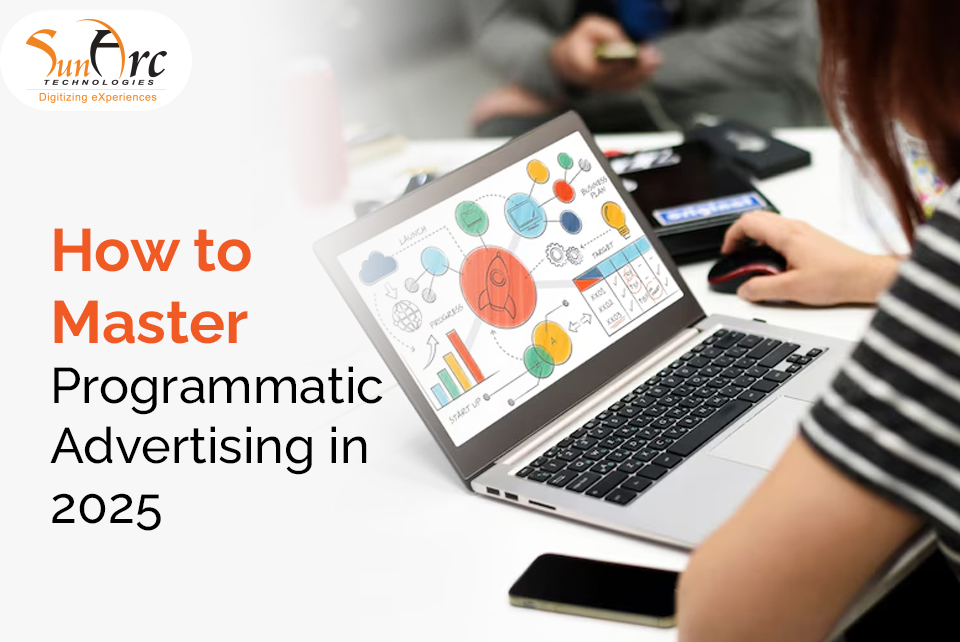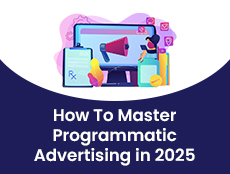Every time you browse a website and see an ad that feels like it was made just for you, chances are, programmatic advertising is at work. Behind the scenes, advanced algorithms are analyzing user data in real time to deliver highly targeted ads across devices and platforms, often in the blink of an eye.
Over the past decade, digital advertising has undergone a major transformation, and at the core of this shift is programmatic advertising. What was once a buzzword or an emerging trend is now the standard approach to media buying in 2025. It allows businesses of all sizes to reach their ideal audience with unmatched precision, scale, and efficiency.
In this blog, we’ll break down everything you need to know about programmatic advertising—from the basics of how it works to the tools, trends, and strategies that are shaping its future. Whether you’re just getting started or looking to level up your ad game, this guide covers you.

1. The Foundation of Modern Media Buying
1.1 Understanding the Concept
What is Programmatic Advertising?
Programmatic advertising refers to the automated buying and selling of digital ad space using technology platforms and artificial intelligence. Unlike traditional ad buying—which involves manual negotiations, insertion orders, and guesswork—programmatic uses real-time systems to place ads in front of the right people at the right time.
How It Differs from Traditional Advertising:
- Traditional ad buying involves direct deals and manual processes.
- Programmatic operates via algorithms and bidding systems.
- Traditional focuses on broad reach; programmatic focuses on precision targeting.
- Real-time insights and optimization are core features of programmatic, unlike the post-campaign reporting of traditional ads.
1.2 Why It Matters in 2025
2025 is a pivotal year for programmatic as global digital ad spend continues to surge. With consumer behavior becoming more dynamic, marketers need a solution that adapts just as quickly, and that’s exactly what programmatic offers.
Key reasons for its growing importance:
- Automation is scaling rapidly, reducing operational effort and improving ROI.
- Users are scattered across devices and platforms, requiring smarter cross-channel strategies.
- Personalization expectations are high, and programmatic is the only scalable solution that delivers it effectively.
2. Core Building Blocks
2.1 The Ecosystem Explained
The programmatic advertising ecosystem functions as a highly automated and interconnected system, involving multiple key components that work together in real-time to buy and sell digital ad space.
- DSP (Demand Side Platform) is a tool used by advertisers to buy ad impressions programmatically. It allows them to define their target audience, set bid prices, manage creative assets, and track performance—all from a single dashboard. Platforms like Google DV360 and The Trade Desk are popular DSPs that give advertisers access to multiple ad exchanges and real-time bidding environments.
- SSP (Supply Side Platform) is used by publishers to manage, sell, and optimize their available ad inventory. Through SSPs like Magnite or PubMatic, publishers can set minimum bid prices, control ad quality, and connect to a wide range of buyers across the digital advertising landscape.
- Ad Exchanges act as digital marketplaces where DSPs and SSPs interact. They conduct real-time auctions where impressions are sold to the highest bidder in milliseconds.
- DMP (Data Management Platform) collects and organizes first- and third-party user data (like browsing behavior, demographics, or purchase history). This data enables more precise audience targeting and ad personalization.
These platforms communicate in real time to bid, purchase, and deliver ads efficiently across the internet.
2.2 Programmatic Ad Types
Programmatic isn’t just one form of media buying. There are multiple types suited for different goals:
- Real-Time Bidding (RTB): Open auction format where impressions are bought per user in milliseconds.
- Programmatic Direct: Deals are made in advance, but ad placement is automated.
- Private Marketplaces (PMPs): Invitation-only auctions between premium publishers and select advertisers.
- Programmatic TV: Serving ads on smart TVs and streaming services using digital automation.
- Programmatic Audio: Ads on digital radio, podcasts, and music streaming platforms like Spotify.
3. How Programmatic Advertising Works
3.1 The Lifecycle of a Programmatic Ad (Detailed)
The journey of a programmatic ad begins the moment a user lands on a webpage. This triggers an ad request, which is automatically sent to an ad exchange—a digital marketplace where advertisers and publishers connect. The request includes user data like browser type, location, device, and more.
Next is the bidding process. Advertisers, using their DSPs, evaluate the incoming data to determine if the user matches their target audience. If so, they place a real-time bid to show their ad. This auction happens within milliseconds.
The placement & delivery follows instantly. The highest bidder wins the auction, and their ad is served in real time on the user’s screen. All of this happens so fast that the user never experiences any delay while the ad loads.
Finally, reporting and optimization kick in. Every impression, click, and engagement is tracked. Marketers use this data to adjust budgets, creatives, or targeting strategies in real time, improving campaign effectiveness.
3.2 The Role of Data and Targeting
Programmatic success hinges on accurate targeting powered by data. Three major targeting methods include:
- Behavioral Targeting: Uses data from user activities—like website visits or purchase history—to serve relevant ads.
- Demographic Targeting: Focuses on attributes such as age, gender, income, and location.
- Contextual Targeting: Matches ads with the content being viewed, ensuring relevance without using personal data.
This layered targeting approach ensures ads reach the most likely audience, increasing ROI and user engagement.
4. Pros and Pitfalls
4.1 Key Benefits
Programmatic advertising has transformed the way digital campaigns are run by bringing automation, intelligence, and scale to the table. Here are its core advantages:
- Precision & Personalization: With access to user-level data, advertisers can serve ads tailored to an individual’s preferences, behaviors, and demographics. This reduces irrelevant impressions and boosts user engagement.
- Real-Time Optimization: Unlike traditional media, programmatic campaigns can be adjusted on the fly. If a creative isn’t performing well or a specific audience segment is converting better, changes can be made instantly to maximize ROI.
- Cost Efficiency: Programmatic lets you bid only on impressions that align with your audience criteria. This reduces ad waste and ensures your budget is spent on high-value users.
- Scalability: Whether targeting a niche audience or expanding globally, programmatic allows campaigns to run across channels—display, mobile, video, audio—through a centralized platform.
4.2 Common Challenges
While powerful, programmatic comes with its own set of hurdles:
- Ad Fraud: One of the biggest threats in digital advertising, fraud can occur through bots generating fake clicks or impressions, leading to wasted budget and inaccurate reporting.
- Platform Complexity: The ecosystem includes DSPs, SSPs, ad exchanges, and DMPs. Without proper training or expertise, managing and optimizing campaigns can become overwhelming.
- Privacy Regulations: As laws like GDPR, CCPA, and others evolve, advertisers must ensure that data collection and usage practices are compliant, or risk legal repercussions.
4.3 Practical Solutions
To overcome these challenges, brands and advertisers can adopt the following best practices:
- Use Ad Verification Tools: Platforms like IAS (Integral Ad Science), MOAT, or DoubleVerify help detect fraud, verify viewability, and ensure brand safety.
- Partner with Reputable Platforms: Working with trusted DSPs and SSPs that prioritize transparency, quality inventory, and fraud prevention reduces risk significantly.
- Invest in Continuous Learning: Enroll in certification programs (like Google, IAB, or The Trade Desk), attend webinars, and stay updated with the latest trends and regulations to maintain a competitive edge and remain compliant.
By proactively addressing these challenges, advertisers can fully leverage the benefits of programmatic while minimizing risks.
5. Tools and Technologies
Programmatic advertising relies on a robust tech stack to function efficiently. Here are the key tools and platforms that drive performance:
5.1 Popular DSPs
Platforms like Google DV360, The Trade Desk, and MediaMath empower advertisers to automate ad buying, target audiences precisely, and optimize campaigns in real time. These DSPs provide access to multiple ad exchanges, audience data, and performance insights—all through a single interface.
5.2 Top SSPs
On the publisher side, Magnite, PubMatic, and OpenX are among the leading SSPs. These platforms help publishers manage, price, and sell their digital ad inventory to the highest bidder while maintaining control over their brand and audience.
5.3 Supporting Tools
To enhance campaign effectiveness:
- Ad Viewability Trackers ensure ads are seen by real users.
- Attribution Tools trace the customer journey and determine which ad interactions led to conversions.
- Centralized Dashboards like Improvado provide unified reporting across platforms, making campaign analysis and optimization easier.
6. Trends to Watch in 2025
As technology continues to evolve, here are the biggest trends shaping programmatic advertising this year:
- Smarter Algorithms & AI: Improved decision-making and predictive targeting.
- Privacy-First Advertising Models: Emphasis on consent, context, and first-party data.
- Programmatic in AR/VR Spaces: Immersive ads in virtual environments.
- Unified Cross-Device Campaigns: Seamless user experience across mobile, desktop, and CTV.
- Enhanced Transparency: Blockchain-based solutions for clearer supply chains.
Conclusion
Programmatic advertising is no longer a futuristic concept—it’s a necessity in today’s fast-moving digital landscape. It offers marketers the ability to automate media buying, target the right audience at the right moment, and optimize campaigns in real time for maximum ROI. With emerging trends like AI-driven bidding, privacy-first frameworks, and cross-device integrations, staying ahead requires both strategic clarity and technical expertise.
This is where SunArc Technologies steps in.
With years of experience in digital advertising, SunArc Technologies helps brands navigate the complex programmatic ecosystem with confidence. Whether you’re launching your first campaign or scaling an existing one, our team offers end-to-end solutions including expert DSP setup and management, real-time optimization and detailed reporting, data privacy-compliant strategies, transparent billing, fraud protection, and highly accurate targeting.
Let SunArc Technologies be your trusted programmatic partner. From planning through execution, we ensure your campaigns are smart, scalable, and successful, driving real business results in the ever-evolving world of digital advertising.

